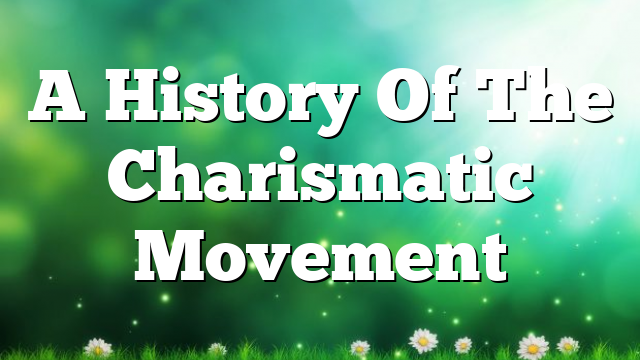Click to join the conversation with over 500,000 Pentecostal believers and scholars
Click to get our FREE MOBILE APP and stay connected
| PentecostalTheology.com



162
Book Reviews / Pneuma 33 (2011) 109-169
Stephen J. Hunt, A History of the Charismatic Movement in Britain and the United States of America: Te Pentecostal Transformation of Christianity, 2 vols (Lewiston, NY: Te Edwin Mellen Press, 2009). 807 pp. $169.95 hardback.
Te scholarly world has long awaited the publication of a comprehensive and definitive history of the Charismatic Movement. We now may have it with the publication of Stephen Hunt’s two volume A History of the Charismatic Movement in Britain and the United States of America. Exhaustively researched and written in a readable and interesting style, this book will be valuable for scholars and casual readers alike who wish to delve into the roots and ongoing story of the worldwide charismatic movement. Although the title seems to limit the book to the United States and Britain, the author also describes Charismatic and Pentecostal developments in many other parts of the world.
Stephen Hunt is a professor of sociology at the University of the West of England. Before this he taught for thirteen years at the University of Reading where he received his PhD degree in 1995 with a dissertation on healing. Although he is not a Charismatic Christian, Hunt has chosen to devote his professional research to the area of Pentecostal and Charis- matic studies. His prior books include: Christian Millenarianism: From the Early Church to Waco (2001), Religion in Western Society (2002), Alternative Religions: A Sociological Intro- duction (2003), and Te Alpha Enterprise (2004). His interest in the charismatic movement came as a youth when he attended a Baptist congregation whose pastor “went Pentecostal” and spoke in tongues. Since then, he developed a consuming interest in all things Pentecos- tal and Charismatic.
Since the book is basically written as a sociological and cultural work, less attention is given to theological and ecclesiastical influences in the story of the movements. Moreover, Hunt strikes an even balance between the beginnings of the movement in the United States and the development of the movement in Britain. Troughout, Hunt shows the important inter-relationships between the American and British movements including the founding of American Pentecostal churches in Britain, such as the Assemblies of God and Church of God, the influence of John Wimber in both countries, and the influence of London’s Holy Trinity Brompton Anglican Church and the worldwide spread of the Alpha Course, espe- cially in the United States. Due attention is also paid to the worldwide influence of the Toronto Blessing movement, the Brownsville awakening, and the Lakeland revival.
In chapters titled “Mainline Renewal: Decline in Britain” and “the Demise of the Catho- lic Charismatic Renewal,” Hunt sees the renewal losing its force and entering into a steep decline in America and Western Europe in the late 1970s symbolized by the closing of the British Fountain Trust in 1981. Although the renewal continued to grow in the Anglican Churches of the world and in America for several more years, it was clear that the renewal had peaked around 1977 and suffered a gradual decline in the mainline churches in the following years. Hunt seems to document the famous statement of Cardinal Suenens that the renewal should eventually “disappear into the life stream of the church.” Perhaps this might be an accurate description of what has been happening in most of the mainline Protestant and Catholic churches, but it does not account for the explosive growth of Pen- tecostalism in the two thirds world in all churches. He does not explain why that after the “demise” of the Renewal in the Roman Catholic Church, there are still some 130 million
© Koninklijke Brill NV, Leiden, 2011 DOI: 10.1163/157007411X555018
1
Book Reviews / Pneuma 33 (2011) 109-169
163
Catholic Charismatics in the world who still have vigorous movements in Africa, South America, and Asia. Also he fails to note that there were still 3,000 Catholic Charismatic prayer groups in the United States in 2010. In the latter chapters, however, Hunt does cover the incredible growth of the African independent Pentecostal churches and the develop- ment of the “Neo-Charismatic” movements around the world that continue to multiply at amazing rates.
Te two volumes are actually one book in two divisions. Te first volume surveys the religious cultures of Britain and the United States and then enters into chapter long his- torical surveys of Classical Pentecostalism, fundamentalism, the Neo-Pentecostal move- ments, John Wimber’s signs and wonders movement, and the gospel of Health and Wealth. Te second volume looks at the prophetic movement, the Toronto blessing movement, the development of the Christian Right with emphasis on Pat Robertson’s run for the presi- dency in 1988, Peter Wagner’s new Apostolic Reformation, and ends with the “the forgot- ten country,” Hunt’s name for the Black churches. In the end he agrees with Phillip Jenkins that the center of Christian growth and influence is rapidly moving to the “global south” and that more than half of the Christians in the world will someday be made up of Pente- costal/Charismatics dominated by the vigorous classical Pentecostal churches and a charis- matically renewed Roman Catholicism.
Tis book is certainly one of the most comprehensive and thoughtful studies of the Charismatic renewal movement to date. It has one of the largest bibliographies I have ever seen on the subject with some thirty eight pages of sources that were consulted or cited in the work. Te bibliography itself is worth the price of the book. In the end, one has to agree with the subtitle of the book, that what Hunt has presented in this major study is the “Pen- tecostal transformation of Christianity.”
Reviewed by Vinson Synan
Dean Emeritus
Regent University School of Divinity, Virginia Beach, Virginia Vinssyn@regent.edu
2


